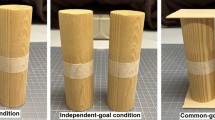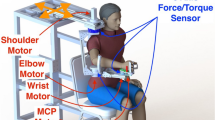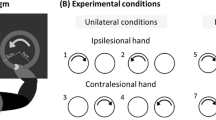Abstract
Upper extremity (UE) hemiparesis results in decreased movement speed and impaired coordination leading to functional limitations and disability. The effects of UE hemiparesis on bilateral functional reaching have not been studied even though most activities of daily living are bilateral tasks. We examined the characteristics of bilateral simultaneous (SIM-B) and bilateral sequential paretic-lead (SEQ-P) and nonparetic-lead (SEQ-NP) functional reaching tasks at preferred and fast speeds. Sixteen patients with chronic hemiparesis completed three bilateral reaching tasks as fast as possible. A subset of eight participants attempted to complete the tasks at both preferred and fastest possible speeds. Paretic (P) and nonparetic (NP) arms were not different from each other in movement time (MT) or peak velocity in the SIM-B condition. MT and peak velocity differed between the two arms during both SEQ tasks. P MT was shorter and NP MT longer in the SIM-B task compared to SEQ-P and SEQ-NP. The P arm MT was the shortest when moving with the NP arm in a simultaneous task compared to both P and NP lead sequential movements. Despite hemiparesis, the two arms demonstrate a temporal coupling when moving simultaneously. When attempting to move at fastest speed, P arm MT time is better when reaching before or with the NP arm than when reaching after the NP arm showing coupling to the NP limb and increased speed of movement. These coupling effects support the rationale for bilateral arm training for individuals with UE hemiparesis.

Similar content being viewed by others
References
Brinkman C (1984) Supplementary motor area of the monkey’s cerebral cortex short- and long-term deficits after unilateral ablation and the effects of subsequent callosal section. J Neurosci 4:918–929
Cauraugh J, Kim S (2002) Two coupled motor recovery protocols are better than one: electromyogram-triggered neuromuscular stimulation and bilateral movements. Stroke 6:1589–1594
Cunningham C, Phillips Stoykov M, Walter C (2002) Bilateral facilitation of motor control in chronic hemiplegia. Acta Psychol 110:321–337
Fugl-Meyer A, Jaasko L, Leyman I, Olsson S, Steglind S (1975) The post-stroke hemiplegic patient. 1. A method for evaluation of physical performance. Scand J Rehabil Med 7:13–31
Gazzaniga MS (1966) Interhemispheric cuing systems remaining after section of neocortical commissures in monkeys. Exp Neurol 16:28–35
Gowland C, deBruin H, Basmajian J, Plews N, Nurcea I (1992) Agonist and antagonist activity during voluntary upper limb movement in patients with stroke. Phys Ther 72:624–633
Kelso J, Southard D, Goodman D (1979) On the coordination of two-handed movements. J Exp Psychol Hum Percept Perform 5:229–238
Lazarus JC (1992) Associated movement in hemiplegia: the effects of force exerted, limb usage and inhibitory training. Arch Phys Med Rehabil 73:1044–1049
Levin M, Cirstae C, Archambault P, Son F, Roby-Brami A (1999) Impairment and Compensation of reaching in hemiparetic and cerebral palsied patients. In: Progress in Motor Control II, Penn State University
Mudie M, Matyas T (2000) Can simultaneous bilateral movement involve the undamaged hemisphere in reconstruction of neural networks damaged by stroke? Disabil Rehabil 22:23–37
Rice M, Newell K (2001) Interlimb coupling in left hemiplegia because of right cerebral vascular accident. Occup Ther J Res 21:12–28
Serrien DJ, Wiesendanger M (2000) Temporal control of a bimanual task in patients with cerebellar dysfunction. Neuropsychologia 38:558–565
Serrien D, Wiesendanger M (2001) Dissociation of grip/load coupling during a bimanual manipulative assignment. Exp Brain Res 136:417–420
Sommerfeld DK, Eek EU, Svensson AK, Holmqvist LW, von Arbin MH (2004) Spasticity after stroke: its occurrence and association with motor impairments and activity limitations. Stroke 35:134–139
Tanji J, Okano K, Sato K (1988) Neuronal activity in cortical motor areas related to ipsilateral, contralateral, and bilateral digit movements of the monkey. J Neurophysiol 60:325–343
Taub E, Wolf SW (1997) Constraint induced movement techniques to facilitate upper extremity use in stroke patients. Top Stroke Rehabil 3:38–61
Taub E, Crago J, Uswatte G (1998) Constraint-induced movement therapy: a new approach to treatment in physical rehabilitation. Rehabil Psychol 43:152–170
Whitall J, McCombe Waller S, Silver KHC, Macko RF (2000) Repetitive bilateral arm training with rhythmic auditory cueing improves motor function in chronic hemiparetic stroke. Stroke 31:2390–2395
Wolf SW, Lecraw D, Barton L, Jan B (1989) Forced use of hemiplegic extremities to reverse the effect of learned nonuse among chronic stroke and head injured patients. Exp Neurol 104:125–132
Wyke M (1971) The effects of brain lesions of the performance of bilateral arm movements. Neuropsychologia 9:33–42
Author information
Authors and Affiliations
Corresponding author
Rights and permissions
About this article
Cite this article
Waller, S.M., Harris-Love, M., Liu, W. et al. Temporal coordination of the arms during bilateral simultaneous and sequential movements in patients with chronic hemiparesis. Exp Brain Res 168, 450–454 (2006). https://doi.org/10.1007/s00221-005-0235-3
Received:
Accepted:
Published:
Issue Date:
DOI: https://doi.org/10.1007/s00221-005-0235-3




